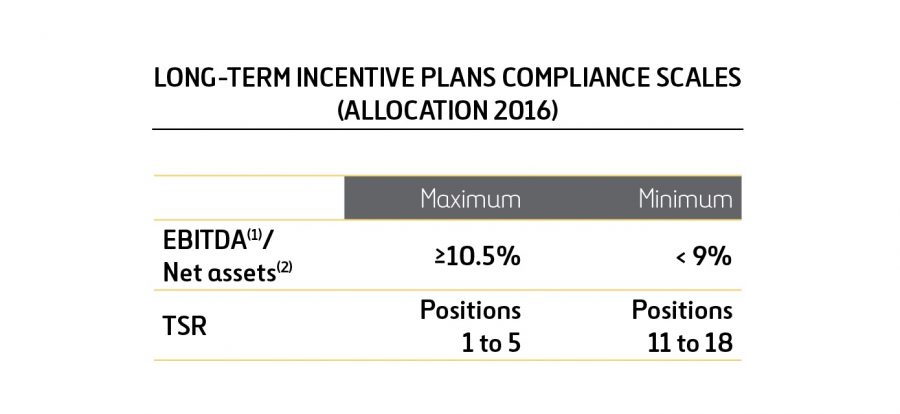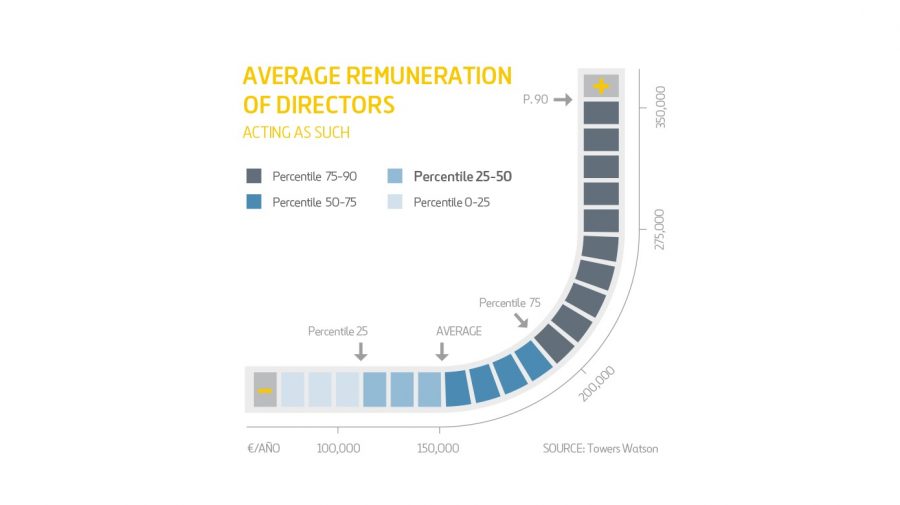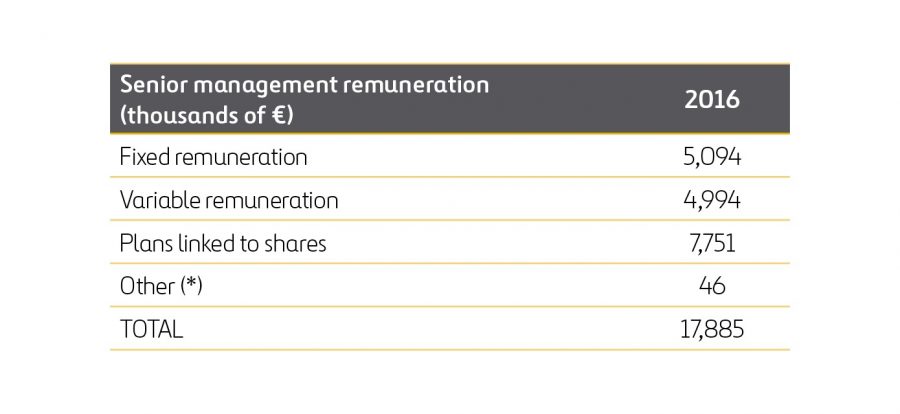Remuneration
Remuneration of Ferrovial's Board of Directors is established on the basis of the best practices in the marketplace and backed by studies on remuneration conducted by external consultants, internal rules and regulations, and pertinent legislation in force.
Remuneration mix of the Chairman and CEO
-
Fixed
13 % -
Variable
20 % -
Long-term incentive
67 % (Includes Performance Shares and Stock Options)
EXECUTIVE DIRECTORS’ REMUNERATION

(1) In March 2016, having fulfilled the agreed metrics, an equivalent number of shares to the units allocated in 2013 were paid after the corresponding retentions were made. The CNMV was informed on 15 March 2016.
(2) The number of stock options in Plan 2008 exercised by Íñigo Meirás was 20,000, while Rafael del Pino exercised 1,179,600, thus finalizing the plan with this period. Similar to all stock option or other plans referenced to the value of the shares granted by Ferrovial since 2000, the Executive Chairman has exercised his option right in the last quarter before the expiration of the plan.
(3) Life assurance premiums/Boards in other companies of the group.
(4) Joaquín Ayuso exercised 200,000 options. This stock options plan was granted to him in 2008 when he was the Executive Director.
Fixed components
The fixed remuneration of the Executive Directors is calculated on the basis of market benchmarks from a comparison group comprising 24 national and international companies in their reference markets.
Variable components
Only Executive Directors have variable component elements in their remuneration. It comprises an Annual Variable Remuneration and Long-Term Incentive Plans.
a) Annual Variable Remuneration
It is linked to individual performance and the attainment of specific economic-financial, industrial and operational targets, which are pre-established, quantifiable and coherent with the social interest, and contemplated in the Strategic Plans. They could be quantitative or qualitative objectives.
In 2016, quantitative objectives have a weight of 50% on the total variable remuneration for the Chairman and 60% for the CEO. They are as follows:
- 45% Net Income.
- 40% Cash Flow.
- 15% Degree of compliance with the initiatives arising from the strategic plan.
Qualitative objectives determine the rest of the Annual Variable Remuneration and in 2016 constitute 50% for the Chairman and 40% for the CEO. The overall results of the Group are assessed for the Chairman while the following objectives are established for the CEO:
- Overall assessment of the results from the reference year.
- Adjustment and monitoring of procedures linked to assuming controlled risks.
- Improvements regarding employee Health & Safety, measured through the accident rate.
- Development of professional teams to guarantee stability in the management and achievement of strategic objectives.
- Innovation and Corporate Social Responsibility.
The target amount of the annual variable remuneration for Executive Directors, i.e., the remuneration corresponding to a standard level of achievement insofar as objectives is equivalent to 125% of the Fixed Remuneration for the Chairman and CEO. The quantitative targets have an associated scale for compensating overachieved targets up to a certain limit, hence the annual variable remuneration has a ceiling of 225% on the Fixed Remuneration for Executive Directors.
b) Long-Term Incentive Plans
Executive Directors participate in a long-term variable remuneration system consisting of share-based remuneration plans. They are structured on overlapping multi-year cycles (currently at 3 years) with yearly unit assignments, which are converted into shares at the end of the cycle (currently 3 years).
For the valid plan (2016 – 2018), they are determined with the relative weighting of the following metrics:
- 70% on the basis of the EBITDA(1) on net productive assets(2).
- 30% based on the Total Shareholder Return (TSR) compared to a group of companies.
In the case of EBITDA/Net productive assets, the incentive maximum will be attained for the allocation in 2016 if the average of this rate at the close of the three-year cycle exceeds 10.5%, with no remuneration under 9%.
The incentive maximum will be attained for the TSR for the allocation in 2016, if Ferrovial ranks among the top 5 for the comparison group at the end of the three years, with no remuneration when underneath the average for this group.

(1). The consolidated EBITDA will be construed as the gross operating result before depreciation, adding the EBITDA from the companies incorporated based on the equity method in the consolidated financial statements in the percentage of stake that the company holds in them.
(2). Net productive assets will be construed for the total amount of the assets in the consolidated balance of the company excluding assets allocatable to projects in an unpaid construction phase. The value corresponding to the proportional part of the net productive assets from the companies integrated by the equity method will then be added to this result, with the exception in any case of the part corresponding to the revaluations of companies stemming from divestment processes with loss of control.
NON-EXECUTIVE DIRECTORS’ REMUNERATION
The remuneration of non-executive directors is determined by a fixed assignment, allowances and a complementary fixed assignment.
Ferrovial’s internal regulations states that remuneration for External Directors will be determined so as to adequately compensate for the responsibility and dedication required by the position without compromising their independence.
Remuneration formulas involving the delivery of shares, options, share-linked instruments or instruments linked to the company’s performance will only apply to Executive Directors.

INTERNAL RULES AND REGULATIONS
Regarding the internal rules and regulations associated with the remuneration of the Board, the following developments in 2016 are noteworthy:
- Approval by the Annual General Meeting of the Remuneration Policy for Directors.
- Adoption of the recommendations of the CNMV’s Code of Good Governance.
- Inclusion of a clawback clause on the variable remuneration of executive directors for cases in which their payment was made on the basis of inaccurate data, and a share tenancy policy.
Further information on the remuneration of the Board of Directors and Senior Management, and on the remuneration policy is available at the Ferrovial website: www.ferrovial.com.

(*) Life assurance premiums/Boards in other companies of the group
Variable remuneration of Executive Directors
- 125 % Target variable remuneration
- 225 % Maximun variable remuneration
Principles and Criteria
- Creating long-term value by aligning remuneration systems with the Strategic Plan.
- Attracting and retaining the finest professionals.
- External competitiveness in the setting of remuneration.
- Periodic involvement in plans linked to this activity and connected with achieving certain profitability metrics.
- Objective compliance pursuant to the Risk Management Policy.
- Maintenance of a reasonable balance between the different fixed remuneration components (short term) and variable components (annual and long term).
- Transparency.

